
Karlanea Brown: Leading Indiana shrimp production for over a decade
December 26, 2023
By Magida Tabbara
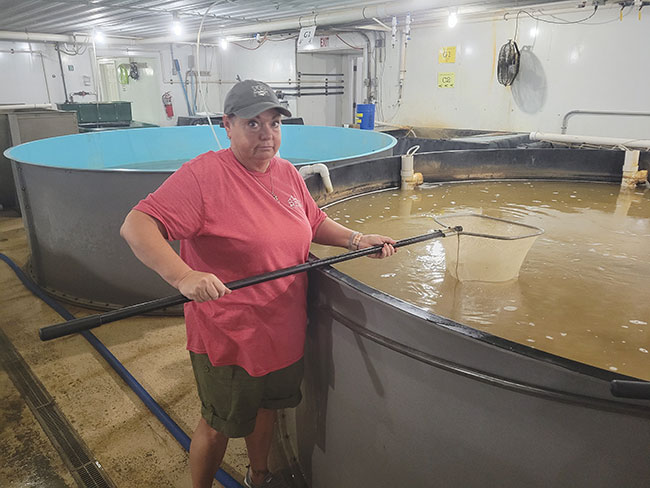 Karlanea Brown physically inspecting the tank and checking up on the shrimp as part of the daily maintenance routine. (Photo: Karlanea Brown)
Karlanea Brown physically inspecting the tank and checking up on the shrimp as part of the daily maintenance routine. (Photo: Karlanea Brown) The beauty of aquaculture, as any other husbandry activity, lies in the act and knowledge that you are providing people with healthy and affordable animal protein, all while “culturing life”. Like in any other sector of production, men and women here share tasks and contributions.
In aquaculture, women make up roughly half of the workforce throughout the entire value chain, from pre- to post-harvest. Majority of those women only participate in post-harvest activities, and a small minority participates in the entire production process.
Data on women in aquaculture in the U.S. is scarce, and a lot of the aquaculture/fisheries facilities do not even collect gender data. Moreover, due to policies and regulations, a lot of the aquaculture facilities in the U.S. are large-scale operations. This means that women find themselves out of the game as most of their participation effort takes place in small-scale production facilities.
But that is not Karlanea Brown. She’s a shrimp farmer, a businesswoman, and an occasional lecturer on aquaculture topics. Together with her husband, Darryl Brown, she owns RDM Shrimp, an indoor shrimp farming facility in Fowler, Ind., where they raise the animals all the way from larvae to market-size adults.
From fashion designer to shrimp farmer
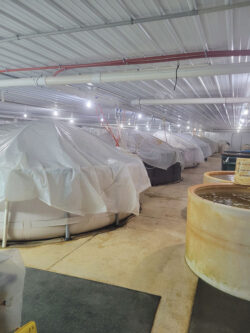
Indoor picture of RDM Shrimp facility. (Photo credit: Karlanea Brown)
“My degree is in fashion design, and the closest I came to aquaculture was that my son won two goldfish in a county fair,” said Brown.
Brown married Darryl, who comes from a hog farming family, in 1991. During that time, hog farming was no longer profitable, so the family’s interest shifted towards aquaculture. They spent the next 15 years learning how to raise tilapia, while Brown was doing her own work and focusing on raising their son.
For her, tilapia was neither the most interesting animal to farm nor the most delicious food. “Shrimp is my favorite seafood to eat”, she said, and the animals seemed more intriguing to her than tilapia.
After deciding to shift to shrimp farming, production tanks needed some preparation to receive the shrimp. Brown’s husband spent over five hours testing water quality in a single tank prior to receiving shrimp “babies”.
At the time, the facility had six production and two nursery tanks, and the water needs to be tested in all of these. “I’m a woman, I multitask, I’ll teach you how to multitask,” she said. That was Brown’s first intervention on the farm. “I never thought that would be something I absolutely love, getting up every morning to do this. I’m here (in the farm) seven days a week.”
The adventure that is farming the shrimp and marketing them began then, with lots of ups and downs, successes and failures, trials, and mistakes. Her success did not stop at shrimp however. With time, the farm was also raising some crayfish and tilapia. Today, RDM shrimp is also experimenting with oyster culture and will hopefully be able to market some in the near future.
“It’s not mainly the shrimp, it’s the water”
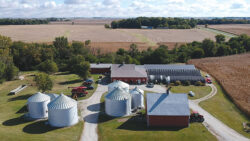
Aerial view of RDM facility in Fowler, Indiana. (Photo: RDM Facebook page)
Brown’s typical day at the farm is spent between checking up on the animals, testing water quality, marketing the product, getting the orders ready for customers, and finishing paperwork. She enjoys every aspect of her work, but the office book work is for sure the least favorite.
“I love to read murder mysteries, I try to solve them by the second chapter and to me the tanks are a mystery, I need to figure them out every day,” she said.
Her clientele is very special, and she enjoys the marketing side of aquaculture because it brings out her creative side. Brown also emphasizes the importance of water quality testing, to the point of making it the farm’s everyday routine maintenance duty.
“I get criticized a lot, testing for nine different water quality parameters every single day in each tank and physically checking up on the shrimp to see how they’re doing.”
However, Brown believes that the key to success is making sure water quality parameters are ideal for the animals and that checking up on the shrimp is done on a daily basis. “If I see shrimp with short antennae, I know there must be something about to happen. The shrimp give me an idea about what’s going on in the tank,” she said.
The earlier the mistake is caught, the faster the problems are resolved, which most of the time ends up being some excess feed or an alkalinity problem that’s easily fixed with little baking soda.
RDM shrimp is the third privately-owned shrimp farm in the United States. With Brown’s contributions, the farm is able to produce over 220 kg of shrimp per month, and that’s in the middle of Fowler, Indiana! Fowler is a small town in the northwest of Indiana, with no access to ocean or lake water. The only possible way to raise shrimp in this area is to wisely employ well water.
Thanks to Brown’s efforts, shrimp survival in the facility quickly rose from 20 to 96 percent with proper water quality management and supplementing the water with probiotics to help improve water quality and shrimp health. The farm produces shrimp under intensive culture conditions, with a stocking density of around 270 shrimp/m2.
“We’ve maintained above 90 percent survival in our tanks for the past 11 years,” which is considered a great challenge in shrimp farming, especially in inland facilities with no access to ocean water. The best thing about the facility is that the shrimp are grown in a biofloc system, or heterotrophic bacteria-based water, which is an eco-friendly culture system with almost zero water exchange.
Nothing stops me
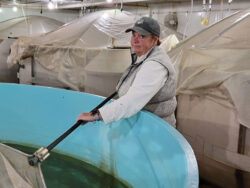
Biofloc system used to raise the shrimp in an eco-friendly manner.
(Photo: Karlanea Brown)
As a woman working in aquaculture, Brown did not face a lot of challenges. “The main thing is not having many letters behind my name. Just because I don’t have a degree in aquaculture, sometimes my ideas get passed over,” she said.
Reality is, founding a shrimp farm in Indiana and getting it to succeed was so full of trials and errors that it gained Brown enough experience to be on par with the professionals in the field.
“Now I can easily carry a conversation with professors and professionals. A lot of people consult me, wanting to become shrimp farmers and they’ve done their homework. I can tell them their methods would work or not because we’ve tried them all,” she said.
Brown occasionally lectures in Purdue University and receives a lot of phone calls afterwards from students’ parents wanting to become shrimp farmers. “Farming is hard work but it’s the most rewarding job ever. I believe in aquaculture, men and women can have the same jobs.”
Brown considers her biggest achievement in aquaculture is getting the farm to last for more than two years. Two years is considered a breakpoint at which the facility is deemed to either succeed or fail. “I absolutely hate it when people tell me I can’t do it,” she said.
The first year the farm lost a million shrimp, and the second year it lost another, but Brown didn’t give up. Instead, she tried to figure it out. It was a rocky road, and Brown had to figure it out on her own considering she did not have a degree in biology or chemistry and was tired of listening to advice that took her nowhere.
“We had to sit and experiment on the shrimp, with temperature and floc density, until we got it right.”
By the farm’s fourth year, enough changes were made for the survival rates to finally go up. “If you keep doing the same thing, you become stagnant,” said Brown, who believes that every day is a learning opportunity and a chance to improve the culture techniques and increase production, and hence profit.
We need more women to help “culture” life
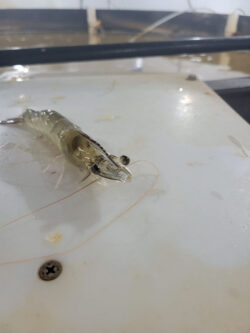
Market-size shrimp from RDM Shrimp. (Photo: Karlanea Brown)
“If you don’t mind getting wet and dirty, go for it,” advised Brown.
Women play an important role in aquaculture, despite most of their involvement being confined to either post-harvest activities or R&D. The significance of their role lies in their participation in the sector, which is a crucial contributor to global food security and is responsible for supporting the livelihood of more than 12 percent of the world’s population.
Aquaculture is very rewarding, and it’s possible to farm in water almost anywhere. “The ocean needs a break, so bring aquaculture inland and have more women in the field,” she said.
More women are needed in aquaculture, especially in the primary sector, where their mental and physical contributions can help improve production and farming techniques. Aquaculture for sure can benefit from more people like Brown, to help improve it and ensure the sustainability of its production, contributing evermore to global food security.
Advertisement
- Laser deterrent system employed at Mississippi fish farm
- UMass Lowell researchers develop portable biosensors for waterborne diseases





